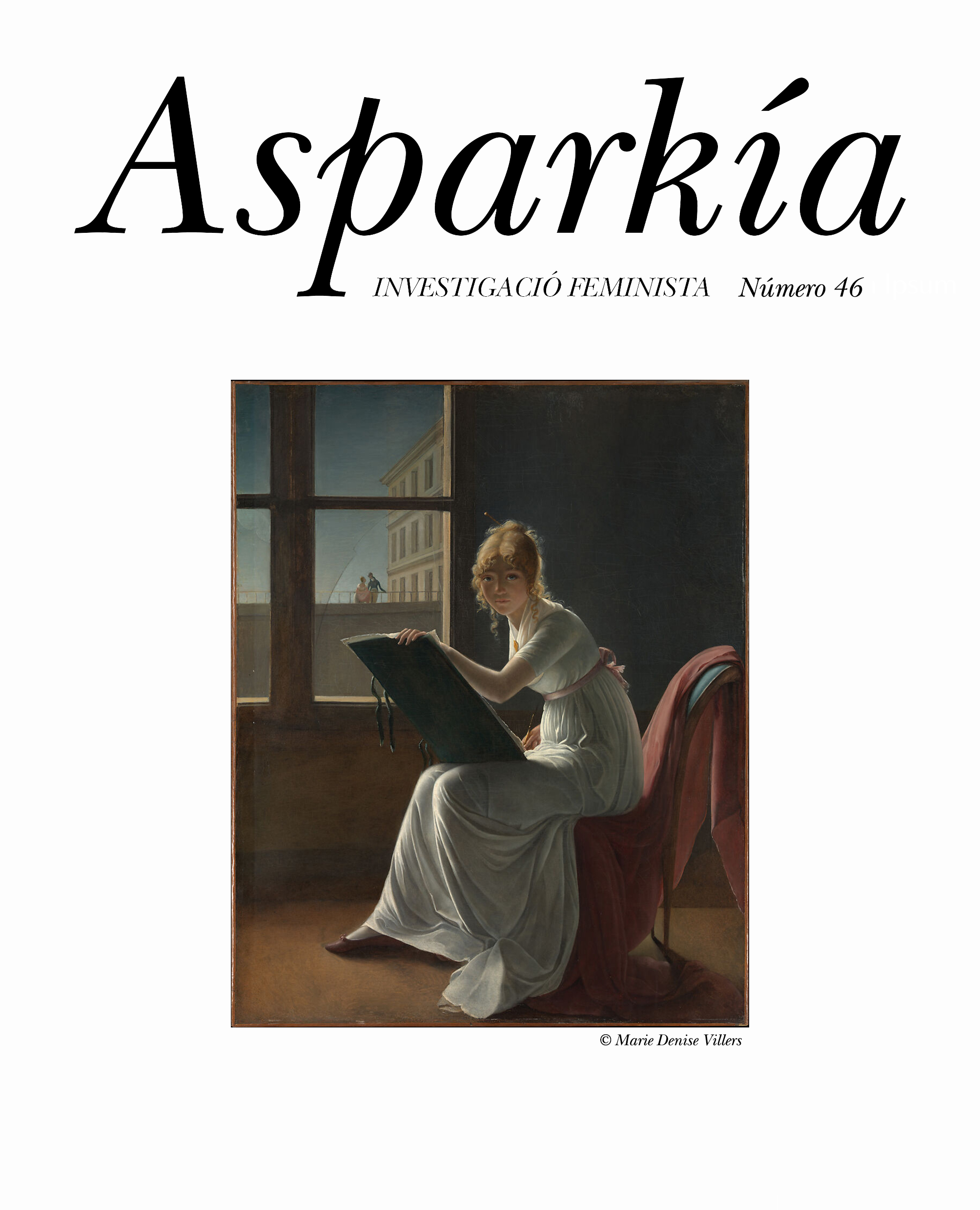Sexual Transgression Space In Fujoshi Texts On X
##plugins.themes.bootstrap3.article.main##
Resum
The popularity of female fans of homosexual fiction stories, known as fujoshi in Japanese, is growing and spreading to several countries, including in Indonesia. The existence of fujoshi was initially linked to the resistance movement against conventional discourse on sexuality. Now, fujoshi have created a transgressive space through text and works of art on social media, especially those uploaded on X. Through the postmodernist perspective and raising gender performativity theory from Judith Butler, this research found that fujoshi in Tapal Kuda tend to camouflage when enjoying boys love content, with the majority of the population being Moslem, they have to put on performances that conform to the teachings of their religion. Among other conclusions, it has been discovered that fujoshi create a zone that better accommodates their interests in homosexual fiction.
Descàrregues
##plugins.themes.bootstrap3.article.details##
Referències
Ani, Yueni Andri. (2018). Fujoshi Ala Indonesia dalam Penciptaan Komik. INVENSI, 3(1), 23-32. https://doi.org/10.24821/invensi.v3i1.2104
Anjanette, Celine. (2019). Konstruksi Femininitas Pria Homoseksual dalam Boys Love. Journal Unair, 2000, 1-11.
Arako. (2019, January 21). Mengenal Fujoshi dan Fenomena di Baliknya. Kompasiana. Beyond Blogging. https://www.kompasiana.com/arakoo/5c453ace6ddcae702159fd48/mengenal-fujoshi-dan-fenomena-di-baliknya
Butler, Judith. (1999). Gender Trouble: Feminism and the Subversion of Identity. Routledge.
Dewi, Surya Rahmi; Gusri, Latifah, & Arif, Ernita. (2020). Construction of Gender Identity in Japanese Popular Culture. MEDIALOG: Jurnal Ilmu Komunikasi, 3(1), 88-95. https://doi.org/10.35326/medialog.v3i1.520
Fitriana, Rossa; Darmawan, Diaz Restu; Efriani, Efriani, & Apriadi, Deny Wahyu. (2021). Gejolak Fujoshi Dalam Media Sosial (Peran Media X Dalam Pembentukan Identitas Kelompok Fujoshi). KIRYOKU: Jurnal Studi Kejepangan, 5(2), 228-235. https://doi.org/10.14710/kiryoku.v5i2.228-235
Foucault, Michel. (1980). A Preference to Transgression in Bouchard, Donald F. (Ed.), Language, Counter-Memory, Practice (pp. 29-52). Cornell University Press.
Hadi Sukmana, Sulaeman; Hidayat, Miwan Kurniawan, & Satriadi, Irawan. (2015). Sekai no toshi saisei. Jurnal Sistem Informasi, 4(1), 73-80. http://www.ejournalab.com/index.php/jsi/article/view/243/pdf
Ihsan, Wahyu, & Thoriq, U. F. (2022). LGBT Dan Liwāt Umat Nabi Luth Dalam Perspektif Tafsir. FUCOSIS, 2, 19-30.
Ilham, Mochamad. (2019). Penganyam Kebudayaan di Tapal Kuda (Issue May). Paguyuban Pandhalungan Jember.
Ishaq, Ropingi El, & Mahanani, Prima Ayu Rizki. (2018). Media sosial, ruang publik, dan budaya ‘pop.’ ETTISAL Journal of Communication, 3(1), 16-27.
Kozinetz, Robert V. (2015). Netnografi: Didefinisikan ulang —pratinjau dua bab pertama. SAGE Publication.
Mahdi, Ivan M. (2022, February 25). Penggunaa Media Media Sosial di Indonesia Capai 191 Juta pada 2022. DataIndonesia.id. https://dataindonesia.id/digital/detail/pengguna-media-sosial-di-indonesia-capai-191-juta-pada-2022
Maimun, Eneng Komariyah, & Rachmani, Tibia Nalurita. (2022). Pengaruh Fiksi Penggemar : Alternate Universe (AU) Dalam Meningkatkan Minat Baca Remaja Indonesia (Studi kasus pembaca Alternative Universe pada fandom treasure makers). Dialektika: Jurnal Bahasa, Sastra, Dan Pendidikan Bahasa Dan Sastra Indonesia, 9(1), 37-56. https://doi.org/10.15408/dialektika.v8i1.25284
Marvasti, Amir B. (2004). Qualitative Research in Sociology. SAGE Publications, Ltd. https://doi.org/10.4135/9781849209700
Moetaqin, Fatharani Silmi. (2020). Budaya Partisipatori Dalam Fandom (Analisis Deskriptif Kualitatif Budaya Partisipatori Fandom “POLCA” sebagai Audiens Media Sosial dalam Mengkonsumsi dan Memproduksi Teks Budaya). Jurnal Komunikasi Massa, 1, 1-10
Putri, Vanya Arisda; Puspitasari, Diana, & Widodo, Heri. (2022). Dekonstruksi Peran Seme dan Uke dalam Manga Shishi mo Kobamazu. Kiryoku, 6(2), 106-116. https://doi.org/10.14710/kiryoku.v6i2.106-116
Rosa, Dien Vidia. (2017). Mempertemukan Hiper-Realitas Dan Refractions Od Duree : Pembacaan Multi-Naratif Visual dalam Film Simone dan Film Inception. CAPTURE: Jurnal Seni Media Rekam, 8(2).
Sheva, Venya Nazia, & Roosiani, Indun. (2022). Pengaruh Genre Boy’s Love pada Komunitas Fujoshi di Indonesia. IDEA : Jurnal Studi Jepang, 4(1), 52-59. https://doi.org/10.33751/idea.v4i1.5212
Sianturi, Sintya Frank, & Junaidi, Ahmad. (2021). Persepsi Penggemar Pasangan Boys Love (BL Ship) terhadap Homoseksualitas. KONEKSI, 5(2), 302-311. https://doi.org/10.24912/kn.v5i2.10312
Syahara, Ade Fristy. (2023). Teks Boys Love Sebagai Media Negosiasi Gender dan Seksualitas Penggemar wanita Text Boys Love as a Media for Negotiating Gender and Sexuality for Female Fans. Journal of Education, Humaniora and Sciences (JEHSS), 5(3), 1971-1980. https://doi.org/10.34007/jehss.v5i3.1567
Tanaka, Hiromi, & Ishida, Saori. (2015). Enjoying Manga as Fujoshi: Exploring its Innovation and Potential for Social Change from a Gender Perspective. International Journal of Behavioral Science, 10(1), 77-85.
Tariuni, Krismi; Musa, Dahniar T., & Gaffar, Zakiah Hasan. (2022). Komunitas Fujoshi di Pontianak dan Stigma Identitas Gender yang Melekat dalam Lingkungan Masyarakat The Fujoshi Community in Pontianak and the Attached Stigma of Gender Identity within the Society. BALELE: Jurnal Antropologi, 3, 1-16.
’Uyun, Zafirah Quroatun; A’yun, Ariza Qurrata, & Rasnika, Wiranda. (2021). Narasi Kuasa Konten Homoseksual di Media Sosial “ Wattpad ”. Jurnal Ilmu Komunikasi, 11(2).
Widiyawati, Aryni Ayu. (2019). Budaya Pandhalungan Sebagai Cultural Heritage Melalui Model Kreatif-Kritis Pembelajaran Sosiologi Kelas XII IPS SMAN 3 Jember. METAFORA: Education, Social Sciences and Humanities Journal, 3(1).
Wisnu, Windu Bramantio, & Rosa, Dien Vidia. (2021). On Air: Representing Osing Identity in Community Radio. Journal of Contemporary Sociological Issues, 1(1), 1-16. https://doi.org/10.19184/csi.v1i1.17712
Zsila, Ágnes; Pagliassotti, Dru; Urbán, Róbert; Orosz, Gábor; Király, Orsolya, & Demetrovics, Zsolt. (2018). Loving the love of boys: Motives for consuming yaoi media. PLoS ONE, 13(6), 1-17. https://doi.org/10.1371/journal.pone.0198895


